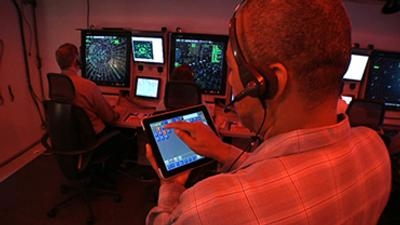Mon, May 27, 2013
Mobile 'Air Traffic Control In A Box' Designed For Global Military Operations, Including Emergency And Humanitarian Missions
The U.S. Air Force has awarded a contract to Raytheon Company to build rapidly deployable air traffic control (ATC) systems that can be delivered anywhere in the world and then be fully operational controlling flights within six hours. The contract, with a potential full value of $260 million, calls for one Engineering and Manufacturing Development unit plus production options for up to 18 Deployable Radar Approach Control (D-RAPCON) systems. The Air Force has authorized Raytheon $50.6 million for the early development stage. Ten of the units will be delivered to the Air National Guard, seven to the active-duty Air Force Space Command, one to the Air Force ATC school and one to the Air Force depot.

D-RAPCON provides sequencing, separation of aircraft, navigation assistance and airspace control services, all with the latest digital sensors, communications equipment and advanced surveillance data processing systems. The Raytheon solution shares many common elements with existing U.S. Department of Defense ATC infrastructure. "Our deployable system capitalizes on many years of investment and testing, and will support safe and efficient airspace operations in areas where air traffic infrastructure is compromised or non-existent," said Joseph Paone, director of Air Traffic Management in Raytheon's Integrated Defense Systems business.
D-RAPCON consists of a transportable antenna plus three trailer-sized shelters that house radar equipment, communications systems, and an operations center with multiple controller work stations. Each station has the same look and feel of what a controller would see at a major airport.
The Raytheon technology builds on proven subsystems, including the Digital Airport Surveillance Radar (DASR) and the Standard Terminal Automation Replacement System (STARS). U.S. Air Force air traffic controllers are trained and certified on STARS, the same automation system they use at the fixed-base ATC sites.

More News
Aero Linx: Model Aeronautical Association of Australia MAAA clubs are about fun flying, camaraderie and community. For over 75 years, the MAAA has been Australia’s largest fl>[...]
Touchdown Zone Lighting Two rows of transverse light bars located symmetrically about the runway centerline normally at 100 foot intervals. The basic system extends 3,000 feet alon>[...]
“Discovery and innovation are central to our mission at Virgin Galactic. We’re excited to build on our successful record of facilitating scientific experiments in subor>[...]
How To Get A Story On Aero-TV News/Feature Programming How do I submit a story idea or lead to Aero-TV? If you would like to submit a story idea or lead, please contact Jim Campbel>[...]
Student Pilot Reported That During Rotation, “All Of A Sudden The Back Of The Plane Kicked To The Right..." Analysis: The student pilot reported that during rotation, “>[...]
 ANN's Daily Aero-Linx (05.02.24)
ANN's Daily Aero-Linx (05.02.24) ANN's Daily Aero-Term (05.02.24): Touchdown Zone Lighting
ANN's Daily Aero-Term (05.02.24): Touchdown Zone Lighting Aero-News: Quote of the Day (05.02.24)
Aero-News: Quote of the Day (05.02.24) ANN FAQ: Contributing To Aero-TV
ANN FAQ: Contributing To Aero-TV NTSB Final Report: Cirrus Design Corp SR20
NTSB Final Report: Cirrus Design Corp SR20




